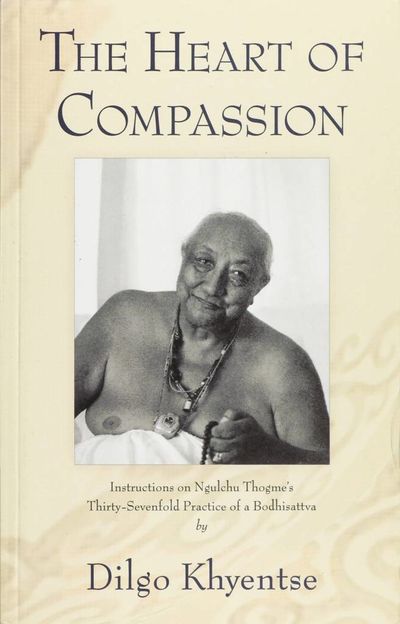- Translator's introduction9
- Gyalse Ngulchu Thogme (1295-1369)11
- THE ROOT TEXT27
- THE COMMENTARY37
- INTRODUCTION39
- OPENING VERSES44
- Homage44
- PART ONE – THE PREPARATION51
- First, the need to give meaning to this human existence of yours, so rare and difficult to obtain51
- Second, an exhortation to abandon your native land, the source of the three poisons58
- Third, a recommendation to live in solitary places, the source of all
good qualities60 - Fourth, to reflect on impermanence, in order to give up the concerns of this life63
- Fifth, the need to avoid unsuitable friends, being with whom creates adverse circumstances68
- Sixth, to rely on a spiritual teacher, whose presence creates conditions favorable to your progress69
- Seventh, to go for refuge, the entrance to the Buddhist teachings72
- PART ONE – THE PREPARATION51
- PART TWO – THE MAIN TEACHINGS, ILLUMINATING THE PATH81
- First, the path for beings of lesser capacity81
- Second, the path for beings of medium capacity85
- Third, the path for beings of superior capacity90
- 1. The bodhicitta of intention90
- 2. The bodhicitta of application97
- I. Relative bodhicitta97
- A. The meditation practice of exchanging oneself and
others98 - B. The post-meditation practice of using unfavorable circumstances on the path106
- i. Using on the path the four things that you do not
want to happen106- a. How to use loss on the path107
- b. How to use suffering on the path109
- c. How to use disgrace on the path111
- d. How to use disparagement on the path112
- ii. Using on the path the two things that are difficult to bear115
- a. How to use on the path being wronged in return for kindness115
- b. How to use humiliation on the path116
- iii. Using deprivation and prosperity on the path117
- a. How to use deprivation on the path117
- b. How to use prosperity on the path119
- iv. Using hatred and desire on the path120
- a. How to use objects of hatred on the path120
- b. How to use objects of desire on the path123
- i. Using on the path the four things that you do not
- A. The meditation practice of exchanging oneself and
- II. Absolute bodhicitta125
- A. The meditation practice of remaining in a state free of conceptual elaborations without any clinging125
- B. The post-meditation practice of abandoning any belief in the objects of desire and aversion as truly existing132
- i. Abandoning any belief in the objects of desire as truly existing132
- ii. Abandoning any belief in the objects of aversion as truly existing133
- I. Relative bodhicitta97
- 3. The precepts for training in those practices136
- I. Training in the Six Transcendent Perfections136
- A. Transcendent generosity136
- B. Transcendent discipline139
- C. Transcendent patience141
- D. Transcendent diligence144
- E. Transcendent concentration148
- F. Transcendent wisdom152
- II. Training in the Four Instructions taught in the Sutra157
- A. To examine oneselffor one's own defects and to give them up 157
- B. To give up speaking of a bodhisattva's faults160
- C. To give up attachment to a sponsor's property163
- D. To give up harsh speech165
- Ill. Training in how to be rid of the negative emotions166
- IV. Training in accomplishing others' good with mindfulness and vigilance170
- V. Dedicating the merit to perfect enlightenment173
- I. Training in the Six Transcendent Perfections136
- PART TWO – THE MAIN TEACHINGS, ILLUMINATING THE PATH81
- CONCLUDING VERSES177
- 1. How and for whom this text was composed177
- 2. The unerring nature of these practices179
- 3. A humble prayer for forgiveness180
- 4. Dedicating the merit of having composed this text181
- 5. The colophon182
- Final Advice182
- About Kyabje Dilgo Khyentse Rinpoche (1910-1991)185
- CONCLUDING VERSES177
- APPENDIX191
- Appendix I • Supplementary Commentaries on the Spiritual Teacher (Verse 6)193
- A. The right and wrong teacher193
- B. A Practice of Guru Yoga195
- Appendix II • Supplementary Commentary on Desire (Verse 21)199
- The Dangers of Meat, Alcohol and Sex199
- Appendix Ill • Supplementary Commentaries on Transcendent Concentration (Verse 29)202
- A. Sustained Calm and Profound Insight202
- B. Concentration206
- Appendix IV • Supplementary Commentaries on Transcendent
Wisdom208 - Appendix V • Mind-Training Prayer211
- Appendix I • Supplementary Commentaries on the Spiritual Teacher (Verse 6)193
- APPENDIX191
- Notes218
- Bibliography230


